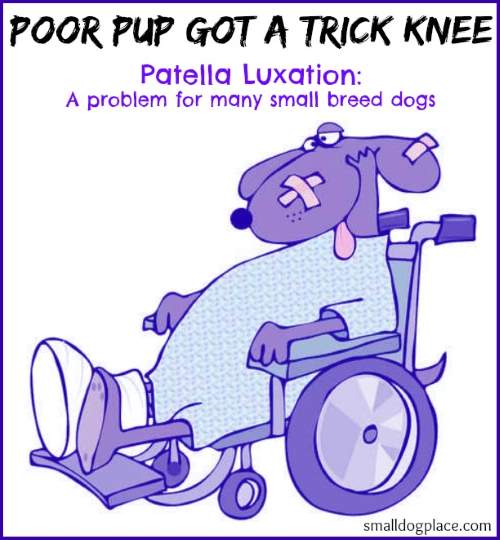- Small Dog Place Home
- Health
- Paellar Luxation
Patellar Luxation: What You Should Know About that Trick Knee
by Janice Jones |Last Updated 05-24-2023
Patellar luxation, luxating patella, dislocated kneecap, trick knee, and floating kneecaps are terms that refer to a condition where the kneecap can move in and out of position.

Patellar luxation occurs mostly in toy and small breeds of dogs weighing 22 pounds or less, but can occur in dogs of all sizes.
In the majority of cases, luxation is a congenital condition and shows up as soon as puppies begin to walk. In other dogs, it may appear some time later.
It is most likely inherited though the exact mode of transmission is not known.
Breeds Affected with Patellar Luxation
Most breeds
that are affected are tiny, small or medium sized dogs. According to the Orthopedic Foundations of
America, the breed most acutely affected is the Pomeranian with a whopping 37.2 percent affected followed by the
Yorkshire Terrier at a rate of 24.4 percent affected.
 Patellar Luxation is very common in Yorkshire Terriers
Patellar Luxation is very common in Yorkshire TerriersOther small breed dogs that may be affected include:
Less common, but still an issue, patellar luxation is diagnosed in these small breed dogs:
Symptoms
A little dog could be having fun running around and playing. Suddenly he stops and holds up his leg as if he can no longer walk.
The next instance, his leg is back to the ground, and he’s back to running and playing. There is usually pain associated with the knee popping out and then again when it pops back in. In young dogs, it's hard to notice this pain because it is fleeting.
You might just see a short limp, even a skip as the dog runs or trots, or a sudden loss of support. Some dogs sit oddly where their knee is placed outward rather than tucked in. Any of these symptoms will be intermittent with the dog returning to normal within a very short period of time.
Over time, the knee cartilage wears thin because of the frequent movement in and out of the grove. At this point, there will be a bone to bone contact, and this is when the dog begins to feel severe pain.
Some dogs may rupture their cranial cruciate ligament. Dogs Naturally Magazine reports that at least 15% to 20% of dogs with patellar luxation will at some point suffer from a cruciate ligament rupture.
Levels of Severity
Veterinarians grade the degree of severity by assigning it to one of four levels:
Grade 1: The Kneecap pops out and then pops right back in. (The veterinarian can manually do this manipulating during a routine office visit) Often newborn puppies will show signs of abnormal hind leg carriage as early as when they start walking.
Grade 2: The kneecap pops out but doesn’t pop back spontaneously and may need help to manually manipulate it back into place.
Grade 3: The kneecap rests outside the grove most of the time, but it can be manually set back where it will only stay for a small time period.
Grade 4: The kneecap remains outside the grove and won’t stay in place even when manually put back in place. Often newborn puppies who eventually get diagnosed with Grade 3 or 4 will show signs of abnormal hind leg carriage as early as when they start walking.
Diagnosis
Veterinarians will likely be able to palpate the knee joint and manually manipulate it in and out of place.
Sometimes sedation is necessary to do this. X-rays or a CAT scan will be helpful and likely ordered if surgery is to occur.
They are also done to rule out or identify other orthopedic problems that may also be affecting the dog.
Treatment Options
Surgery would be the last treatment of choice, especially if the dog diagnosed with a grade 3 or 4 luxated patella.
During surgery, the veterinarian will carve out a deeper groove at the end of the femur so that the kneecap can remain in place. If there is a ruptured ligament, it can be repaired at the same time.
But before surgery is scheduled there are other things that you can do to improve the dog’s overall quality of life.
Most dogs with a mild problem will live their entire life without needing surgery. A few life changes can keep the dog quite comfortable.
According to Dr. Karen Becker, there are several steps that you can do. She recommends that dogs with this problem maintain a healthy body weight. Less stress will limit any stress on those joints.
She also suggests that the dog should keep moving, which is in direct contrast to older thinking that recommended dogs remain as still as possible.
Lastly, she encourages you to provide an oral joint supplement such as chondroitin/glucosamine.
Dr. Julie Mayer, a holistic vet, and owner of Integrative Pet Care and operator of Therapist in Chicago, recommends certain exercises that can help with the condition.
Among the treatments that she encourages includes swimming and underwater treadmills, going up and down carpeted steps several times a day and leg weights.
Pain relievers and anti-inflammatory drugs may also be prescribed and may make the dog more comfortable.
Changing the diet or adding additional nutrients can also be effective. The goal of supplements is to control inflammation and inflammation and prevent osteoarthritis.
At the same time, the diet should supply antioxidants, provide building blocks for the synthesis of collagen and promote healthy connective tissue.
Breeding
Since this is an inherited condition, dogs that are affected should not be bred.
About Janice (author and voice behind this site)
Janice Jones has lived with dogs and cats for most of her life and worked as a veterinary technician for over a decade. She has also been a small-breed dog breeder and rescue advocate and holds academic training in psychology, biology, nursing, and mental health counseling. Her work focuses on helping dog owners make informed, responsible decisions rooted in experience, education, and compassion.
When not writing, reading, or researching dog-related topics, she likes to spend time with her six Shih Tzu dogs, her husband, and her family, as well as knitting and crocheting. She is also the voice behind Miracle Shih Tzu and Smart-Knit-Crocheting
Does This Article Deserve Your Thumbs Up?
We always appreciate your support and encouragement. Your thumbs up means so much to us. Please like this article.
If you find this page or any page on Small Dog Place Helpful, or useful in anyway, I'd love it if you would click the small heart found on the bottom right of each page.
You can also share or bookmark this page -- just click on the:

Free Monthly Newsletter
Sign Up for Our Free Newsletter and get our Free Gift to You.
my E-book, The Top 10 Mistakes People Make When Choosing a Dog (and how to avoid them)

